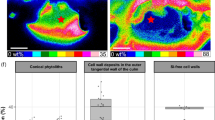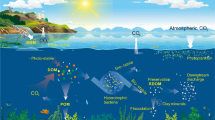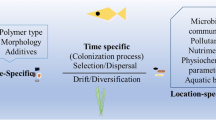Abstract
ORGANIC matter preserved in marine sediments provides a molecular record of marine biological processes1, accounts for approximately 20% of all carbon burial2 and plays a key role in balancing the long-term flux of oxygen to the atmosphere3. Only recently has it been appreciated that more than 90% of the organic matter preserved in most marine sediments is intimately associated with mineral surfaces4. Little is known, however, of the effect that sorption to mineral surfaces might have in controlling either the lability or quantity of organic matter in the marine sedimentary record. The preserved organic material could be either intrinsically stable, or stabilized through interactions with mineral matrices. We show here that sorption of organic matter to mineral surfaces in marine sediments stabilizes the component molecules, slowing remineralization rates by up to five orders of magnitude. Sorptive protection can therefore account for the enigmatic preservation of intrinsically labile molecules such as amino acids and simple sugars in marine deposits5,6 and links the preservation of organic carbon in marine sediments to the deposition of mineral surfaces.
Similar content being viewed by others
References
Summons, R. E. in Organic Geochemistry (eds Engel, M. & Macko, S.) 1–21 (Plenum, New York, 1993).
Berner, R. A. Am. J. Sci. 282, 451–473 (1982).
Berner, R. A. Globl planet. Change 1, 97–122 (1989).
Mayer, L. M. in Organic Geochemistry (eds Engel, M. & Macko, S.) 171–183 (Plenum, New York, 1993).
Hedges, J. I. Mar. Chem. 39, 67–94 (1992).
Henrichs, S. M. in Organic Geochemistry (eds Engel, M. & Macko, S.) 101–117 (Plenum, New York, 1993).
Keil, R. G., Tsamakis, E., Fuh, C. B., Giddings, J. C. & Hedges, J. I. Geochim. cosmochim. Acta 58, 879–893 (1994).
Mayer, L. M. Geochim. cosmochim. Acta 58, 1271–1284 (1994).
Eglinton, G. in Organic Geochemistry (eds Eglinton, G. & Murphy, M. T. J.) 20–71 (Springer, New York, 1969).
Henrichs, S. M. & Sugai, S. F. Geochim. cosmochim. Acta 57, 823–835 (1993).
Pinck, L. A. & Allison, F. E. Science 114, 130–131 (1951).
Wang, X-C. & Lee, C. Mar. Chem. 44, 1–24 (1993).
Marshman, N. A. & Marshall, K. C. Soil Biol. Biochem. 13, 127–134 (1981).
Ogram, A. V. et al. Appl. envir. Microbiol. 49, 582–587 (1985).
van Loosdrecht, M. C. M. et al. Microbiol. Rev. 54, 75–87 (1990).
Doyle, L. J. & Garrels, R. M. Geo-Mar. Lett. 5, 51–53 (1985).
Berner, R. A. Am. J. Sci. 291, 339–376 (1991).
Keil, R. G. & Kirchman, D. L. Mar. Ecol. Prog. Ser. 73, 1–10 (1991).
Author information
Authors and Affiliations
Rights and permissions
About this article
Cite this article
Keil, R., Montluçon, D., Prahl, F. et al. Sorptive preservation of labile organic matter in marine sediments. Nature 370, 549–552 (1994). https://doi.org/10.1038/370549a0
Received:
Accepted:
Issue Date:
DOI: https://doi.org/10.1038/370549a0
- Springer Nature Limited
This article is cited by
-
Assessing the impact of the global subsea telecommunications network on sedimentary organic carbon stocks
Nature Communications (2023)
-
Seasonally variable interactions between dissolved organic matter and mineral particles in an agricultural river
Aquatic Sciences (2023)
-
The effect of iron on the preservation of organic carbon in marine sediments and its implications for carbon sequestration
Science China Earth Sciences (2023)
-
Mineralogical control on methylotrophic methanogenesis and implications for cryptic methane cycling in marine surface sediment
Nature Communications (2022)
-
Retention of soil organic matter by occlusion within soil minerals
Reviews in Environmental Science and Bio/Technology (2022)





